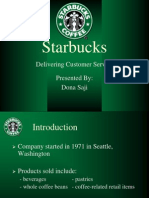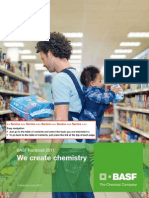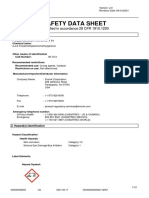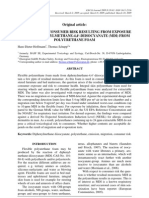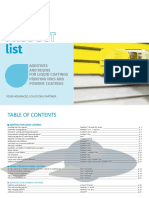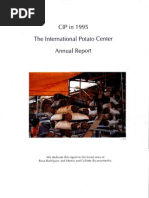Bavistin (Basf)
Bavistin (Basf)
Uploaded by
Drhmsa1994Copyright:
Available Formats
Bavistin (Basf)
Bavistin (Basf)
Uploaded by
Drhmsa1994Original Title
Copyright
Available Formats
Share this document
Did you find this document useful?
Is this content inappropriate?
Copyright:
Available Formats
Bavistin (Basf)
Bavistin (Basf)
Uploaded by
Drhmsa1994Copyright:
Available Formats
POISON KEEP OUT OF REACH OF CHILDREN READ SAFETY DIRECTIONS BEFORE OPENING OR USING
SYSTEMIC FUNGICIDE Active Constituent: 500 g/L CARBENDAZIM
A broad spectrum, systemic fungicide for the control of fungal diseases in various crops as per the DIRECTIONS FOR USE table.
GENERAL INSTRUCTIONS FUNGICIDE RESISTANCE WARNING
BAVISTIN FL Fungicide is a GROUP FUNGICIDE member of the benzimidazole group of fungicides. For fungicide resistance management BAVISTIN FL is a Group A fungicide. Some naturally occurring fungal populations resistant to BAVISTIN FL and other Group A fungicides may exist through normal genetic variability in any fungal population. The resistant individuals can eventually dominate the fungi population if these fungicides are used repeatedly. These resistant fungi will not be controlled by BAVISTIN FL and other Group A fungicides, thus resulting in a reduction in efficacy and possible yield loss. Since the occurrence of resistant fungi is difficult to detect prior to use, BASF Australia Ltd accepts no liability for any losses that may result from the failure of BAVISTIN FL to control resistant fungi. Refer to specific Avcare Resistance Management Strategies, below. Stone Fruit Blossom Blight and Brown Rot Resistance Management Strategy 1. If applying Group A, B or C fungicides, do NOT apply more than two consecutive sprays of fungicides from the same group before changing to another group. 2. A post-harvest dip should also be counted as an application. 3. The last blossom blight spray and the first pre-harvest brown rot spray should be regarded as consecutive applications. 4. The spray program should be considered and the strategy applied on a whole-orchard basis. 5. Sound management practices such as good control of insects, removal of fruit mummies by pruning, and burying diseased fruit will help to reduce disease pressure and further help to avoid resistance. Grape Grey Mould (Bunch Rot) Resistance Management Strategy 1. If three or fewer bunch rot sprays are applied in a season use only one spray per season containing a Group A fungicide. If four or more bunch rot sprays are applied in a season use no more than 2 sprays containing Group A fungicide, unless tank mixed with a registered multi-site (Group Y) fungicide. 2. Late season fungicide treatments should be applied before botrytis infection reaches unacceptably high levels in the vineyard. 3. Do NOT apply more than 2 consecutive sprays from the same fungicide group, including from the end of one season to the next. Grey Mould of Strawberries Resistance Management Strategy 1. Apply a program of protectant fungicides during flowering. If conditions favour disease development during this period, tank mix the protectant with a Group A or B fungicide. 2. Applications of Group A or B fungicides on their own should be confined to the harvest period only. 3. Avoid applying more than two successive sprays of a fungicide of the same chemical group during flowering and fruit ripening. 4. Alternate or tank mix different fungicide groups during fruit ripening. 5. Reduce background levels of disease by removing plant debris and rotted fruit. Cucurbits Powdery Mildew Resistance Management Strategy 1. Start disease control early. Do NOT wait for powdery mildew to appear before spraying, but start as soon as practicable after crop emergence. 2. Use protectant sprays in early crop growth. Apply protectant sprays up to the fruit set stage of the crop if the disease normally occurs during this period. If this schedule is interrupted (eg. by rain) use a tank mix of protectant plus systemic before recommencing the protectant program. 3. After fruit set, use systemic fungicides in one or more of the following ways: (a) Tank mix systemic fungicides with a protectant fungicide AND use fungicides from at least 2 different systemic activity groups per crop. (b) Alternate systemic fungicides with a protectant fungicide AND use fungicides from at least 2 different systemic activity groups per crop.
(c) Alternate systemic fungicides from at least 3 different activity groups per crop. Post-Harvest Dipping of Fruit Resistance Management Strategy 1. Handle fruit carefully to minimise potential infection sites caused by injury. 2. Ensure diseased fruit is promptly removed from the field and packing house and destroyed. 3. Dip fruit with a recommended fungicide promptly after harvest. 4. Dont store fruit in the packing house - move it through the packing house quickly. 5. Dispose of mouldy fungicide-treated fruit at harvest - do NOT bring it into the packing house. 6. For the last pre-harvest spray, use a fungicide with a different mode of action to the fungicide planned for use as a post-harvest dip. 7. Resistant strains of fungi can develop within the packing house. Where alternatives are available, rotate to use as many different modes of action as possible. 8. Remove mouldy fruit from storage - isolate from other fruit. 9. Do NOT move fruit between packing houses - especially mouldy fruit. Turf Diseases - Resistance Management Strategy Do NOT apply more than two consecutive sprays of fungicides from the same activity group, unless mixed with a fungicide from a different activity group. Export of Treated Produce Growers should note that suitable MRLs or import tolerances may not be established in all markets for produce treated with BAVISTIN. If you are growing produce for export, please check with BASF for the latest information on MRLs and import tolerances BEFORE using BAVISTIN.
PROTECTION OF LIVESTOCK
BAVISTIN FL is of low toxicity to bees.
PROTECTION OF WILDLIFE, FISH, CRUSTACEANS AND ENVIRONMENT
Do NOT contaminate streams, rivers or waterways with this product or the used containers.
STORAGE AND DISPOSAL
Store in the closed, original container in a cool, wellventilated area. Do NOT store for prolonged periods in direct sunlight. Triple or preferably pressure rinse containers before disposal. Add rinsings to spray tank. Do NOT dispose of undiluted chemicals on-site. If recycling, replace cap and return clean containers to recycler or designated collection point. If not recycling, break, crush, or puncture and bury empty containers in a local authority landfill. If no landfill is available, bury the containers below 500 mm in a disposal pit specifically marked and set up for this purpose clear of waterways, desirable vegetation and tree roots. Empty containers and product should NOT be burnt.
DIP DISPOSAL
Unused or spent dip should be disposed of carefully to avoid contamination of streams, rivers or waterways. Dispose of dip by pouring evenly into a limed disposal pit, specifically marked and set up for this purpose clear of waterways, desirable vegetation and tree roots. Alternatively, spray onto grassed areas where runoff to waterways, leaching to ground water or grazing by animals will not occur.
DRIFT WARNING
Do NOT apply under meteorological conditions or from spraying equipment which could be expected to cause spray to drift onto adjacent crops, crop lands, pastures or livestock.
APPLICATION
High Volume (dilute spraying) Apply in sufficient water to thoroughly wet the crop to the point of run-off. The water volume should increase as the crop size and bulk increases. Where a range of rates is specified, use the higher rate when disease pressure is high. Low Volume (concentrate spraying) Where a rate per hectare (ha) is specified, apply in sufficient water to ensure thorough, even coverage of all plant parts. Where a range of rates is specified, use the higher rate when disease pressure is high. Where no rate per hectare is specified, the rate per hectare should be based on that which would be applied per hectare if high volume (dilute) application was used.
PRECAUTION
Keep away from foodstuffs. Grapevine leaves treated with BAVISTIN FL must not be used for human consumption.
SAFETY DIRECTIONS
May irritate the eyes and skin. Avoid contact with eyes and skin. When opening the container, preparing and using the prepared spray or dip, wear cotton overalls buttoned to the neck and wrist, a washable hat and elbow-length PVC gloves. Wash hands after use. After each days use, wash gloves and contaminated clothing.
FIRST AID
If poisoning occurs, contact a doctor or Poisons Information Centre. Telephone 131126 Australia-wide.
COMPATIBILITY
BAVISTIN FL is compatible with many insecticides and fungicides, however to be sure of compatibility with any particular product check with your local dealer first.
MSDS
Additional information is listed in the Material Safety Data Sheet.
MIXING
SHAKE WELL BEFORE USE. BAVISTIN FL is a liquid suspension to be mixed with water for application as a spray or a dip. Add the required quantity of BAVISTIN FL to a partly filled spray tank and agitate. Complete filling while agitating. Ensure the spray mixture is properly agitated before restarting after stoppage. Addition of Wetting Agent The addition of an approved, non-ionic wetting agent to the spray mixture improves the distribution of the spray on hard to wet plants.
RE-ENTRY PERIOD
Do NOT allow entry into treated areas until the spray deposits have dried. When prior entry is necessary, wear cotton overalls buttoned to the neck and wrist and elbowlength PVC gloves. Clothing must be laundered after each days use. For glasshouses and other confined areas, do not re-enter until spray deposits have dried and area has been thoroughly ventilated.
DIRECTIONS FOR USE CROP Apples DISEASE Powdery mildew (Podosphaera leucotricha) Black spot (Venturia inaequalis) STATE RATE WHP 7 days CRITICAL COMMENTS Apply at 7 to 10 day intervals until petal fall. Use the higher rate when disease pressure is high.
All States 40 or 50 mL/100 L NSW, Vic, Tas, SA, WA only 40 or 50 mL/100 L
Blue mould (Penicillium expansum)
All States 50 mL/ 100 L
Post-Harvest Dipping: Submerge fruit for approximately 30 seconds. Top up dip at the recommended application rate of 50 mL/100 L. Dipping should occur within 24 hours of harvest. Tas Only: Always apply the treatment whenever the apples are to be dipped in diphenylamine prior to storage. This use is subject to an Avcare Resistance Management Strategy: Refer to Resistance Management Strategy under General Instructions. Post-Harvest Dipping: Submerge fruit for approximately 30 seconds. This use is subject to an Avcare Resistance Management Strategy: Refer to Resistance Management Strategy under General Instructions. Post-Harvest Dipping: Submerge fruit for approximately 30 seconds. This use is subject to an Avcare Resistance Management Strategy: Refer to Resistance Management Strategy under General Instructions. Begin application when disease first appears, repeat at 7 to 14 day intervals. Use the higher rate and shorter intervals when disease pressure is high and plants are growing rapidly. This use is subject to an Avcare Resistance Management Strategy: Refer to Resistance Management Strategy under General Instructions. Cut seed pieces to desired length from Rhizomes free of rot. Submerge for 5 minutes and allow to dry before planting. Apply at early flowering, 80 to 100% capfall and pre-bunch closure. Further applications may be necessary at veraison and pre-harvest, if wet weather favours infection. High volume application should be made in sufficient water to obtain thorough coverage of the crop. For application close to harvest this would require a minimum of 1100 L/ha. For low volume application, the spray pressure should be high enough to ensure penetration of the leaf canopy and coverage of the bunches. This use is subject to an Avcare Resistance Management Strategy: Refer to Resistance Management Strategy under General Instructions.
Bananas
Crown rot (Colletotrichum musae)
Qld, NSW, WA only
40 mL/ 100 L
Citrus
Blue and green moulds (Penicillium spp.)
Qld, NSW, Vic, SA, WA only
100 mL/ 100 L
Cucurbits
Powdery mildew (Sphaerotheca fuliginea)
Qld, NSW, Vic, Tas, SA, WA only
HIGH VOLUME: 40 or 50 mL/100 L LOW VOLUME: 400 or 550 mL/ ha 200 mL/ 100 L
Ginger seed pieces
Rhizome/seed piece rot (Fusarium spp.)
Qld, WA only
Grapes
Grey mould (Botrytis cinerea)
All States HIGH 1 day VOLUME: 100 mL/ 100 L LOW VOLUME: 1.1 L/ha
CROP Mango
DISEASE Anthracnose (Colletotrichum spp.) and stem end rot (Dothiorella spp.)
STATE Qld, NSW, WA, NT only
RATE 100 mL/ 100 L
WHP
CRITICAL COMMENTS Post-Harvest Dipping: Submerge for approximately 5 minutes at 52C. This use is subject to an Avcare Resistance Management Strategy: Refer to Resistance Management Strategy under General Instructions. Apply at closing-up of pasture in a minimum spray volume of 150 L/ha. Repeat 30 days later if there is a build up of disease. Use the higher rate if disease is well established at closing-up; repeat at this rate 30 days later if disease continues to develop. Apply at 7 to 10 day intervals until petal fall. Use the higher rate when disease pressure is high. Post-Harvest Dipping: Submerge fruit for approximately 30 seconds. Top up dip at the recommended application rate of 50 mL/100 L. Dipping should occur within 24 hours of harvest. This use is subject to an Avcare Resistance Management Strategy: Refer to Resistance Management Strategy under General Instructions. Begin application when disease first appears and repeat at 7 to 14 day intervals throughout the growing season. Shorten intervals during humid weather.
Pasture
Clover scorch (Kabatiella caulivora)
Vic, Tas, SA, WA only WA only
Cercospora (Cercospora zebrina) Pears Black spot (Venturia pirina)
300 or 550 mL/ ha plus 1 L/ 100 L summer spray oil
14 days
Blue mould (Penicillium expansum)
NSW, 25 or 50 Vic, Tas, mL/100 L SA, WA only All States 50 mL/ 100 L
7 days
Roses
Powdery mildew (Oidium spp.)
Black spot (Diplocarpon rosae) Stone fruit Blossom blight (Monilinia fructicola)
All States 25 mL plus 1 L Oil (98-99% summer oil) per 100 L 50 mL/ 100 L Qld, NSW, Vic, Tas, SA, WA only 25 or 50 mL/100 L
1 day
Apply at pink or white bud stage, 10% blossom and petal fall. Apply the higher rate when disease pressure is high. This use is subject to an Avcare Resistance Management Strategy: Refer to Resistance Management Strategy under General Instructions. Apply 3 weeks and 1 week prior to harvest following early application of Blossom Blight sprays. This use is subject to an Avcare Resistance Management Strategy: Refer to Resistance Management Strategy under General Instructions. Submerge fruit for approximately 30 seconds. Use higher rate where disease pressure is severe or where longer term storage is required. This use is subject to an Avcare Resistance Management Strategy: Refer to Resistance Management Strategy under General Instructions.
Brown rot (Monilinia fructicola)
Qld, NSW, Vic, Tas, SA, WA only
40 mL/ 100 L
As post-harvest dip for brown rot (Monilinia & Sclerotinia spp.)
Qld, NSW, Vic, Tas, SA, WA only
50 or 100 mL/100 L
CROP
DISEASE
STATE NSW, Vic, Tas, SA, WA only
RATE 40 or 50 mL/100 L
WHP 2 days
CRITICAL COMMENTS Begin application when disease first appears or at flowering and repeat at 7 to 14 day intervals. Use higher rates and shorter intervals when disease pressure is high. This use is subject to an Avcare Resistance Management Strategy: Refer to Resistance Management Strategy under General Instructions. Apply to cut seed pieces as a dip or spray so as to obtain thorough wetting. After dipping allow to drain. When replenishing dip, top up with 65 mL BAVISTIN FL in 100 L water. Apply in sufficient water to give good coverage. Commence application at beginning of damp weather and repeat at intervals of 4 weeks. This use is subject to an Avcare Resistance Management Strategy: Refer to Resistance Management Strategy under General Instructions.
Strawberries Grey mould (Botrytis cinerea)
Sugar cane
Pineapple disease (Ceratocystis paradoxa)
Qld, NSW, WA only
65 mL/ 100 L
Turf
Dollar spot (Sclerotinia homoeocarpa)
Qld, NSW, Vic, SA, WA only
60 mL/ 100 m2
NOT TO BE USED FOR ANY PURPOSE, OR IN ANY MANNER, CONTRARY TO THIS LABEL UNLESS AUTHORISED UNDER APPROPRIATE LEGISLATION. WITHHOLDING PERIODS (WHP): GRAPES, STONE FRUIT: DO NOT STRAWBERRIES: DO NOT APPLES, PEARS: DO NOT PASTURE: DO NOT
HARVEST FOR 1 DAY AFTER APPLICATION. HARVEST FOR 2 DAYS AFTER APPLICATION. HARVEST FOR 7 DAYS AFTER APPLICATION. GRAZE OR CUT FOR STOCK FOOD FOR 14 DAYS AFTER APPLICATION.
EMERGENCY INFORMATION PANEL ENVIRONMENTALLY HAZARDOUS SUBSTANCE, LIQUID, N.O.S. (CONTAINS CARBENDAZIM) UN NO. 3082
IN A TRANSPORT EMERGENCY DIAL: 000 POLICE OR FIRE BRIGADE FOR SPECIALIST ADVICE IN AN EMERGENCY ONLY PHONE 1 800 033 111 TOLL FREE ALL HOURS AUSTRALIA-WIDE BASF Australia Ltd ABN 62 008 437 867 Norwest Business Park, 7 Maitland Place Baulkham Hills NSW 2153 Customer Service Telephone: 1800 635 550 Customer Service Fax: 1800 630 005 Product Information Line: 1800 501 940 Fax On Demand: 0500 544 044
CONDITIONS OF SALE: All conditions and warranties rights and remedies implied by law or arising in contract or tort whether due to the negligence of BASF Australia Ltd. or otherwise are hereby expressly excluded so far as the same may legally be done provided however that any rights of the Buyer pursuant to non excludable conditions or warranties of the Trade Practices Act 1974 or any relevant legislation of any State are expressly preserved but the liability of BASF Australia Ltd. or any intermediate Seller pursuant thereto shall be limited if so permitted by the said legislation to the replacement of the goods sold or the supply of equivalent goods and all liability for indirect or consequential loss or damage of whatsoever nature is expressly excluded. This product must be used or applied strictly in accordance with the instructions appearing hereon. This product is sold solely for use in Australia and must not be exported without the prior written consent of BASF Australia Ltd. = Registered trademarks of BASF Copyright, 2001 NRA Approval No.: 30399
You might also like
- Stratergic Management Case Study On StarbucksDocument30 pagesStratergic Management Case Study On StarbucksRahul Sttud50% (2)
- I Believe in Miracles PDFDocument30 pagesI Believe in Miracles PDFTamsil SarfrazNo ratings yet
- Rhodapex AB 20 U MSDSDocument13 pagesRhodapex AB 20 U MSDSFernando García PachecoNo ratings yet
- Water ProofingDocument3 pagesWater ProofingmichaelNo ratings yet
- BASF MasterProtect 8000 CIDocument4 pagesBASF MasterProtect 8000 CIHJNo ratings yet
- Why Is Roguing ImportantDocument1 pageWhy Is Roguing Importantpapotchi patototNo ratings yet
- Cake Making: by Mrs. M. PittDocument31 pagesCake Making: by Mrs. M. PittErich Viray100% (1)
- 2nd Year English Book 2 Synonyms ImportantDocument9 pages2nd Year English Book 2 Synonyms ImportantDesdemona Luis78% (9)
- The Great Thanksgiving Escape Activity KitDocument5 pagesThe Great Thanksgiving Escape Activity KitCandlewick PressNo ratings yet
- HALALIFY Com Ram Ad An Battle PlanDocument58 pagesHALALIFY Com Ram Ad An Battle Plankit265No ratings yet
- 3 BASF Group List of Shares Held 2019 Pursuant To Section 313 (2) of The German Commercial Code (HGB)Document15 pages3 BASF Group List of Shares Held 2019 Pursuant To Section 313 (2) of The German Commercial Code (HGB)HoangNo ratings yet
- Bamboo Cafe 2022Document4 pagesBamboo Cafe 2022Roniel Urbino GamboaNo ratings yet
- Leaflet Vandex Crystalline WaterproofingDocument12 pagesLeaflet Vandex Crystalline WaterproofingEngr. Mohammad Moinul HossainNo ratings yet
- China Tunnel WaterproofingDocument7 pagesChina Tunnel WaterproofingSharifah NormalaNo ratings yet
- The Use of Filter Aids On Iron Ore FinesDocument4 pagesThe Use of Filter Aids On Iron Ore Finesvitaliy khmelNo ratings yet
- Baxxodur: Amines For Epoxy and Polyurea ApplicationsDocument2 pagesBaxxodur: Amines For Epoxy and Polyurea ApplicationsEldhoseNo ratings yet
- Dispex AA4140 - Dispex N40Document3 pagesDispex AA4140 - Dispex N40Duodo NguyenNo ratings yet
- Basf Masterbrace Fibers TdsDocument2 pagesBasf Masterbrace Fibers TdsAPURV GOYALNo ratings yet
- BASF Factbook 2011Document96 pagesBASF Factbook 2011reneroessler2113No ratings yet
- MSDS IzonilDocument2 pagesMSDS Izonilabdul azizNo ratings yet
- BASF - Underground - AmstrongDocument33 pagesBASF - Underground - AmstrongrizanindyaNo ratings yet
- ACOUSTICRYL™ AV-1331 Copolymer Emulsion: Regional Product Availability DescriptionDocument3 pagesACOUSTICRYL™ AV-1331 Copolymer Emulsion: Regional Product Availability DescriptionJaved ShaikhNo ratings yet
- BASFDocument1 pageBASFmehul10941No ratings yet
- Coatings Word October 2010Document52 pagesCoatings Word October 2010sami_sakrNo ratings yet
- BASF in India Manufactures PolymersDocument3 pagesBASF in India Manufactures PolymersmeetsarkarNo ratings yet
- Masterflow 885: High-Precision, Non-Shrink Metallic Aggregate Grout With Extended Working TimeDocument4 pagesMasterflow 885: High-Precision, Non-Shrink Metallic Aggregate Grout With Extended Working TimeSky MoonNo ratings yet
- CHRYSO - GCP - Waterproofing - Expanson Joint - SubmittalDocument22 pagesCHRYSO - GCP - Waterproofing - Expanson Joint - Submittalsubhasishg1985No ratings yet
- MSDS Epikure 548Document13 pagesMSDS Epikure 548trường phạmNo ratings yet
- Basf Masterseal 550 TdsDocument3 pagesBasf Masterseal 550 Tdsraza102No ratings yet
- ELASTENE 1500 DCM-APR TDS en Final - 1501Document2 pagesELASTENE 1500 DCM-APR TDS en Final - 1501rogerkid17No ratings yet
- Desalination SokalanThermalAdditivesDocument6 pagesDesalination SokalanThermalAdditivesSourabha DehadraiNo ratings yet
- Products - Inspired by LifeDocument59 pagesProducts - Inspired by Lifezaryab khanNo ratings yet
- Lumiflon Fe4300: FEVE Waterborne Resin PolyolDocument2 pagesLumiflon Fe4300: FEVE Waterborne Resin PolyolDuodo NguyenNo ratings yet
- 10 Adhesive and SealantsDocument34 pages10 Adhesive and SealantsAngel Mine AlcantaraNo ratings yet
- Brochure Hostatint 500Document4 pagesBrochure Hostatint 500Pablo Mariño MuñizNo ratings yet
- Coatings Word December 2012Document52 pagesCoatings Word December 2012sami_sakrNo ratings yet
- Asphalts Catalog Tcm14-55227Document54 pagesAsphalts Catalog Tcm14-55227Savaşer YetişNo ratings yet
- United States Patent (10) Patent No.: US 8.263,231 B2Document13 pagesUnited States Patent (10) Patent No.: US 8.263,231 B2Alexander Franco CastrillonNo ratings yet
- Safety Data Sheet: Classified in Accordance 29 CFR 1910.1200Document12 pagesSafety Data Sheet: Classified in Accordance 29 CFR 1910.1200Irma BermudezNo ratings yet
- BRB Siloen SR 383-1Document2 pagesBRB Siloen SR 383-1m daneshpour100% (1)
- Residual MDI in FoamDocument8 pagesResidual MDI in FoambehowardNo ratings yet
- Sewage Treatment PlantDocument38 pagesSewage Treatment PlantNirupam Kolankiroll 55No ratings yet
- Jotun Group Report 2019 - tcm279-199782Document82 pagesJotun Group Report 2019 - tcm279-199782Anonymous ed8Y8fCxkS100% (1)
- BASF Mastertop 538 DSDocument3 pagesBASF Mastertop 538 DSSaud PathiranaNo ratings yet
- Drying Technology: Please Scroll Down For ArticleDocument7 pagesDrying Technology: Please Scroll Down For ArticleJessica EliseNo ratings yet
- From Antibacterial To Antibiofilm Targeting: An Emerging Paradigm Shift in The Development of Quaternary Ammonium Compounds (Qacs)Document29 pagesFrom Antibacterial To Antibiofilm Targeting: An Emerging Paradigm Shift in The Development of Quaternary Ammonium Compounds (Qacs)KATIA PAMELA VILLAVICENCIO SANCHEZNo ratings yet
- Basf 8160 SpecificationsDocument2 pagesBasf 8160 Specificationswongpengchiong7205100% (1)
- Effect of Extrem Conditions On Polyurea CoatingsDocument5 pagesEffect of Extrem Conditions On Polyurea CoatingsJamaya PiaNo ratings yet
- AdmixturesDocument41 pagesAdmixturesPurvi SharmaNo ratings yet
- Astm D6578 00Document6 pagesAstm D6578 00Soundara PandianNo ratings yet
- BASF AcresinDocument38 pagesBASF AcresinauogdouNo ratings yet
- SDReport Listing 36156Document5 pagesSDReport Listing 36156j.saiyathNo ratings yet
- 843 02105 01 Architectural and Industrial Coatings Solutions Selection GuideDocument20 pages843 02105 01 Architectural and Industrial Coatings Solutions Selection GuidenanoNo ratings yet
- SYNTHRON - PRODUCT LIST ADDITIVES FOR COATINGS v12 - JCADocument16 pagesSYNTHRON - PRODUCT LIST ADDITIVES FOR COATINGS v12 - JCACarlos Lizarraga FloresNo ratings yet
- Project 5 Louise Nicole Yu - Resume 2019Document1 pageProject 5 Louise Nicole Yu - Resume 2019api-457735342No ratings yet
- BioethanolDocument12 pagesBioethanolRuvimbo ShokoNo ratings yet
- Deshuttering OilDocument2 pagesDeshuttering Oilnickdash09No ratings yet
- Marine PaintDocument12 pagesMarine PaintWagiyanto MulyaNo ratings yet
- Croda Kiss Technology-Pigment WettingDocument36 pagesCroda Kiss Technology-Pigment WettingLuis Felipe BenavidesNo ratings yet
- 2016 BASF ArchitecturalCoatingsBrochure ELDocument64 pages2016 BASF ArchitecturalCoatingsBrochure ELLong An DoNo ratings yet
- Dokumen - Tips - Biofertilizer Business PlanDocument52 pagesDokumen - Tips - Biofertilizer Business PlanMisgana HotelNo ratings yet
- Waterbar Application ManualDocument6 pagesWaterbar Application ManualbarouniamineNo ratings yet
- Bituminous MaterialsDocument24 pagesBituminous MaterialsGimanthaNo ratings yet
- Sitren Airvoid 320 en Oi 0218Document1 pageSitren Airvoid 320 en Oi 0218JuanCamiloLemaZambranoNo ratings yet
- Intumescent Paint For Steel NZ - Coating - Co.nzDocument8 pagesIntumescent Paint For Steel NZ - Coating - Co.nzPeter ThomsonNo ratings yet
- Coconut Milk Drop Velvet BB CreamDocument1 pageCoconut Milk Drop Velvet BB CreamSandieNo ratings yet
- Chess Insecticide LabelDocument4 pagesChess Insecticide LabelssangachonuerNo ratings yet
- Spearker RecogDocument19 pagesSpearker RecogDrhmsa1994No ratings yet
- L01 - Introduction To Inf. Sys.Document30 pagesL01 - Introduction To Inf. Sys.Drhmsa1994No ratings yet
- Bavistin (Fungicide)Document3 pagesBavistin (Fungicide)Drhmsa1994No ratings yet
- Tm9090b Option-User ManualDocument40 pagesTm9090b Option-User ManualDrhmsa19940% (1)
- Diabetes Class of Medication 2011Document1 pageDiabetes Class of Medication 2011Drhmsa1994No ratings yet
- One Minute To Learn Programming: Finite Automata: A B A BDocument50 pagesOne Minute To Learn Programming: Finite Automata: A B A BDrhmsa1994No ratings yet
- E-Mail Tools: David HilleyDocument21 pagesE-Mail Tools: David HilleyDrhmsa1994No ratings yet
- Glucose ValuesDocument1 pageGlucose ValuesDrhmsa1994No ratings yet
- Suger Free Chocolate Chart 02 06Document1 pageSuger Free Chocolate Chart 02 06Drhmsa1994No ratings yet
- Payroll - Guide (Old System)Document328 pagesPayroll - Guide (Old System)Drhmsa1994No ratings yet
- Cisco Cost CalculatorDocument6 pagesCisco Cost CalculatorDrhmsa1994No ratings yet
- Determination of Vitamin B12 in Food Products and in Premixes by HPLCDocument6 pagesDetermination of Vitamin B12 in Food Products and in Premixes by HPLCDaniel Dávila MartinezNo ratings yet
- Izombie: Season 1 Episode 1Document7 pagesIzombie: Season 1 Episode 1Divya NandiniNo ratings yet
- Fiona Maxwell: Fi Is A SurvivorDocument3 pagesFiona Maxwell: Fi Is A SurvivorJohnny Warhawk ONeillNo ratings yet
- Highball GlassDocument4 pagesHighball GlassJocelyn Cabreros-VargasNo ratings yet
- Melissa Medina Resume PrincipalDocument3 pagesMelissa Medina Resume Principalapi-508354968No ratings yet
- Student:Ciocoi Liliana, gr.L11: Chișinău 2017Document21 pagesStudent:Ciocoi Liliana, gr.L11: Chișinău 2017LilianaNo ratings yet
- Fish Feed TechnoogyDocument49 pagesFish Feed TechnoogyShubham Patidar100% (1)
- Past ContinuousDocument12 pagesPast ContinuousSimiciuc SilviuNo ratings yet
- MythDocument2 pagesMythStephanie GaNo ratings yet
- Project Report On Engro FoodsDocument73 pagesProject Report On Engro FoodsMuhammad Irfan84% (25)
- My New Routine: Eat Lunch Take A ShowerDocument6 pagesMy New Routine: Eat Lunch Take A ShowerEDWIN VASMARNo ratings yet
- Cosmetic Allergen CertificateDocument1 pageCosmetic Allergen CertificateJeevan de SilvaNo ratings yet
- Topics For Environmental SciencesDocument4 pagesTopics For Environmental SciencesEkansh SrivastavaNo ratings yet
- Food Spoilage PPT 711c4Document17 pagesFood Spoilage PPT 711c4ayanakhter149209No ratings yet
- CIP Annual Report 1995Document56 pagesCIP Annual Report 1995cip-libraryNo ratings yet
- Unit13 OutboundDocument6 pagesUnit13 OutboundNguyễn Gia ToànNo ratings yet
- Antioxidants, Their Properties, Uses in Food Products and Their Legal ImplicationsDocument24 pagesAntioxidants, Their Properties, Uses in Food Products and Their Legal ImplicationsIndrajitNo ratings yet
- Threatend AbortionDocument5 pagesThreatend AbortionJohn Walter Torre100% (1)
- A001848 - OxESP Booklet - Agriculture - RevisedDocument24 pagesA001848 - OxESP Booklet - Agriculture - RevisedYolanda CatuognoNo ratings yet
- Phytosanitary CertificateDocument1 pagePhytosanitary CertificateKim TranNo ratings yet
- BtS4 - T1 Reading - EXAM PREPRATIONDocument21 pagesBtS4 - T1 Reading - EXAM PREPRATIONshaden salehNo ratings yet
- Too Much Many Too Adjective Exercises With AkDocument2 pagesToo Much Many Too Adjective Exercises With Akapi-520203796No ratings yet
- CRAVEABLES-MENU ProjectDocument8 pagesCRAVEABLES-MENU Projectraulchristopher desturaNo ratings yet
